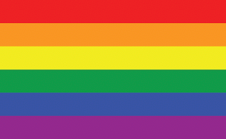Rainbows fly proudly this June for Pride Month – helping to improve the visibility of LGBT+ people. This article aims to provide a brief history of arguably the most important symbol of the LGBT+ people: The Pride Flag.
In the 1970s a number of symbols were used to represent the community, the most common being the triangle; which at first glance seems odd considering its origin.
Homosexuals were one of the groups persecuted by the Nazis and sent to concentration camps where they were identified by an inverted triangle sewn onto their clothing. The Star of David was used to identify Jewish prisoners. A black triangle was used for homosexual women, and a pink one for homosexual men, bisexual men and transgender women.
The community has a long tradition of reclaiming and taking ownership of insults and abusive terms in order to neutralise them. For example, many LGBT+ people proudly describe themselves as ‘queer’ although others still see this as an insult. So the triangle symbol was adopted by the LGBT+ community, in part as a mark of remembrance, but also as a symbol of identity and defiance; in later years the triangle was often displayed pointing upwards, showing that the negative association of the symbol had been overturned into a positive one, and symbols like these remained in common use until the mid-1990s.
The Pride or rainbow flag was the brainchild of Gilbert Baker and first flown at the San Francisco Gay Freedom Parade in 1978. This parade, in common with the many Pride parades that now occur around the world, took place to commemorate the Stonewall uprising that had occurred nearly 10 years before in New York, in response police brutality against gay people. 
Since 1978, the inclusive six-striped flag design gained popularity throughout the community with the rainbow, and its composite colours becoming a powerful, positive symbol of LGBT+ Pride. By the end of the twentieth century, the rainbow was almost universally recognised around the world and became the most significant symbol of the LGBTQ+ community. When asked people often describe the flag’s meaning as ‘safety’, ‘acceptance’, ‘pride’, ‘visibility’, and ‘freedom’. LGBT+ people associate the rainbow symbol with so-called ‘safe spaces’, where they can be confident that they will be accepted and free from abuse.
The Pride flag itself has been constant for over four decades, acting as an inclusive umbrella symbol for the community. Since its creation, several variations have been created to represent different LGBT+ identities and groups. The most common variations being the dark pink, purple and blue stripes of the bisexual flag and the pale pink, white and pale blue stripes of the transgender pride flag.